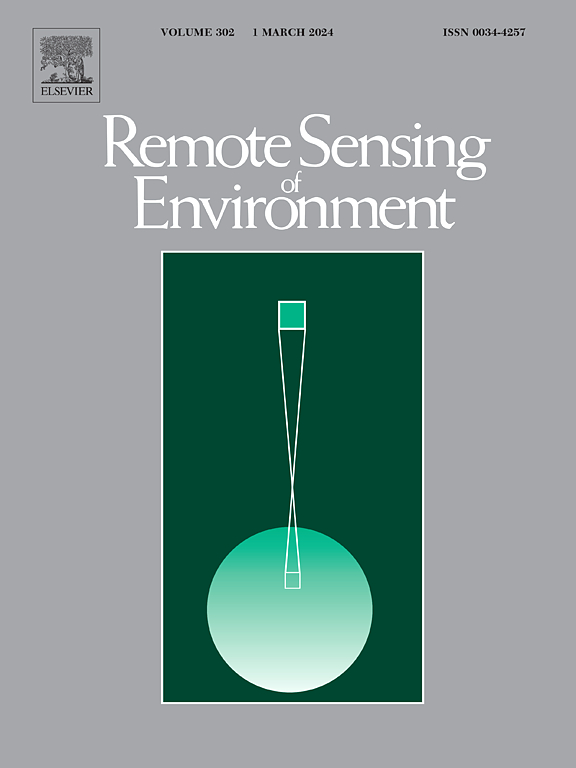利用Himawari-8同步卫星和气象网格的亚日地空温差异常早期检测植被干旱胁迫:在澳大利亚2017-2019年Tinderbox干旱中的应用
IF 11.4
1区 地球科学
Q1 ENVIRONMENTAL SCIENCES
引用次数: 0
摘要
卫星地表温度(Ts)通过其与植物气孔活动和蒸腾的物理联系提供了植被干旱胁迫的宝贵信息。新一代地球同步卫星提供了监测t的亚日变化的机会,从而跟踪植物在亚日时间尺度上发生的生理应激反应。然而,卫星t及其衍生指标在可见冠层变化发生之前早期发现植被干旱胁迫的潜力尚未得到广泛评估。利用Himawari-8地球同步卫星的Ts和气象网格的逐时气温(Ta)在上午晚些时候到下午早些时候的累积次日差,开发了一种简洁的地空温差异常(SATDA)方法来跟踪植被干旱胁迫。SATDA利用Ts−Ta作为感热通量(H)的物理驱动梯度来捕获由于植物蒸腾减少而引起的异常感热。我们利用SATDA监测了2017-2019年澳大利亚东南部Tinderbox干旱的时空格局。我们将SATDA在预测可见的干旱引起的植被绿度下降方面的技能作为基准,对照传统的基于水分的指数(即降水和土壤湿度异常)和现有的卫星Ts指数(即温度条件指数和温升指数),在不同的气候和土地覆盖下进行测试。SATDA有效捕获了多年火药箱干旱(Tinderbox drought)中持续数周时间尺度(2019年7月至9月)的快速加剧的山火干旱事件,这对农业生产造成了不利影响,并增加了野火风险。在过渡性半干旱和半湿润气候条件下,SATDA对植被绿度的预测效果最好,提前32 d预测相关系数为>;0.5。在以木本为主的生态系统中,水分有效性指数的优势比以草本为主的生态系统更明显,这可能是由于树木在干旱期间的生理调节(如更深的根和更强的气孔控制)的重要性。基于Ts−Ta的SATDA对植被绿度的预测总体上优于单纯的两种Ts指数,尤其是对木本植被的预测。最后,随着干旱强度的增加,SATDA在预测可见植被下降方面始终比基于水分有效性和仅基于水分有效性的指数具有更大的优势。基于简化过程的SATDA方法适合全球尺度的业务实施,以补充植被干旱监测和预警系统。本文章由计算机程序翻译,如有差异,请以英文原文为准。
Using sub-diurnal surface-air temperature difference anomaly derived from Himawari-8 geostationary satellite and meteorological grids for early detection of vegetation drought stress: Application to Australia's 2017–2019 Tinderbox Drought
Satellite land surface temperature () provides valuable information on vegetation drought stress via its physical linkage to plant stomatal activity and transpiration. New-generation geostationary satellites offer opportunities to monitor sub-diurnal variations in and thus track plant physiological stress response occurring at sub-daily timescales. Nevertheless, the potential of satellite and its derived metrics for early detection of vegetation drought stress before visible canopy changes occur has not been widely assessed. Here, we developed a parsimonious Surface-Air Temperature Difference Anomaly (SATDA) method for tracking vegetation drought stress using the cumulative sub-diurnal difference from late-morning to early-afternoon between from the Himawari-8 geostationary satellite and hourly air temperature () from meteorological grids. SATDA utilised as the physical driving gradient for sensible heat flux (H) to capture anomalous sensible heating due to reduced plant transpiration. We used SATDA to monitor the spatio-temporal patterns of the 2017–2019 Tinderbox Drought in southeast Australia. We benchmarked the skill of SATDA in forecasting visible drought-induced vegetation greenness decline against both conventional water availability-based indices (i.e., precipitation and soil moisture anomalies) and existing satellite indices (i.e., Temperature Condition Index and Temperature Rise Index) across diverse climates and land covers. SATDA effectively captured a rapidly intensifying flash drought event at multi-week timescales (Jul to Sep 2019) embedded within the multi-year Tinderbox Drought, which contributed to detrimental impacts on agricultural production and increased wildfire risk. SATDA showed the best vegetation greenness forecast skill in the transitional semi-arid and sub-humid climates, with forecast correlation >0.5 at 32-day lead time. The advantage over water availability-based indices was more evident in woody-dominated ecosystems than herbaceous-dominated ecosystems, likely due to the importance of physiological regulations by trees during droughts such as deeper roots and stronger stomatal control. SATDA, based on , showed overall better vegetation greenness forecasts than two -only indices, especially in woody vegetation. Finally, SATDA showed consistently greater advantage over water availability-based and -only indices in forecasting visible vegetation decline as the drought intensity increased. The parsimonious process-based SATDA method suits global-scale operational implementation to complement vegetation drought monitoring and early warning systems.
求助全文
通过发布文献求助,成功后即可免费获取论文全文。
去求助
来源期刊

Remote Sensing of Environment
环境科学-成像科学与照相技术
CiteScore
25.10
自引率
8.90%
发文量
455
审稿时长
53 days
期刊介绍:
Remote Sensing of Environment (RSE) serves the Earth observation community by disseminating results on the theory, science, applications, and technology that contribute to advancing the field of remote sensing. With a thoroughly interdisciplinary approach, RSE encompasses terrestrial, oceanic, and atmospheric sensing.
The journal emphasizes biophysical and quantitative approaches to remote sensing at local to global scales, covering a diverse range of applications and techniques.
RSE serves as a vital platform for the exchange of knowledge and advancements in the dynamic field of remote sensing.
 求助内容:
求助内容: 应助结果提醒方式:
应助结果提醒方式:


